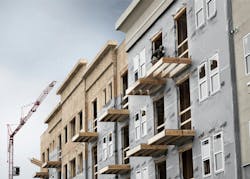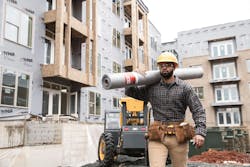Building Wrap and the Code; What you Need to Know
Building wraps (also known as house wraps or WRBs) have been a popular method of protecting building enclosures against moisture intrusion for more than 50 years due to their durability and ease of installation. However, before specifying the WRB on your next project, be sure to know how the code could impact your selection.
The 2018 International Building Code (IBC), Section 1402.2, “Weather Protection,” requires exterior walls “provide the building with a weather-resistant exterior wall envelope…designed and constructed in such a manner as to prevent the accumulation of water within the wall assembly by providing a water-resistive barrier behind the exterior veneer…and a means for draining water that enters the assembly to the exterior.”
This water-resistive barrier, as defined by Section 1403.2, “Weather Protection,” comprises at least “one layer of No. 15 asphalt felt, complying with ASTM D226, Standard Specification for Asphalt-Saturated Organic Felt Used in Roofing and Waterproofing, for Type 1 felt or other approved materials…attached to the studs or sheathing.”
It is important to note the difference between a weather-resistant barrier and a water-resistant barrier, as they have distinct purposes but are often confused with one another. The American Architectural Manufacturers Association (AAMA) defines WRBs as a surface or a wall responsible for preventing air and water infiltration to the building interior. The differentiating factor is a WRB must also prevent air infiltration, while water-resistant barriers are only responsible for stopping water intrusion.
WRBs are commonly specified for commercial buildings or projects where a higher level of performance is desired of the vertical building enclosure and when it is critical to have greater control of interior environmental conditions. Water-resistant barriers, on the other hand, are usually limited to residential and low-rise structures.
The International Code Council-Evaluation Service (ICC-ES) evaluates the following key performance characteristics for building wrap. These characteristics provide a valuable starting point for deciding which product best suits a specific project.
- Water Resistance - A building wrap should be able to pass both “water ponding” tests, which measure a house wrap’s resistance to a pond of 25 mm (1 in.) water over two hours, and a more stringent hydrostatic pressure test where the wrap is subjected to a pressurized column of water for five hours.
- Air Resistance - For an individual building material to be classified as an air barrier, its air permeance must be equal to or less than 0.02 L/(s-m2) @ 75 Pa when tested in accordance with ASTM E2178, Standard Test Method for Air Permeance of Building Materials. However, this air permeance test only measures the amount of air migrating through the material itself and not through holes or gaps in the larger assembly.
- Durability - The ICC-ES looks at the tear resistance and tensile strength as the best measure of a building wrap’s durability, since it must be able to withstand the handling and application process without compromising its water resistance.
- Vapor Permeability - When selecting a building wrap, look for one that hits the “sweet spot” of 10 to 20 perms to achieve the desired balance of moisture protection and drying capacity.
- Flammability - Class A fire rating is the industry standard for WRBs. Ensure the WRB you’re using meet these requirements.
Changing building codes and greater adoption of certain cladding materials have caused specifiers to take a closer look at how moisture is managed in the wall assembly. Advances in building wrap products have added a powerful tool to help achieve these goals.


